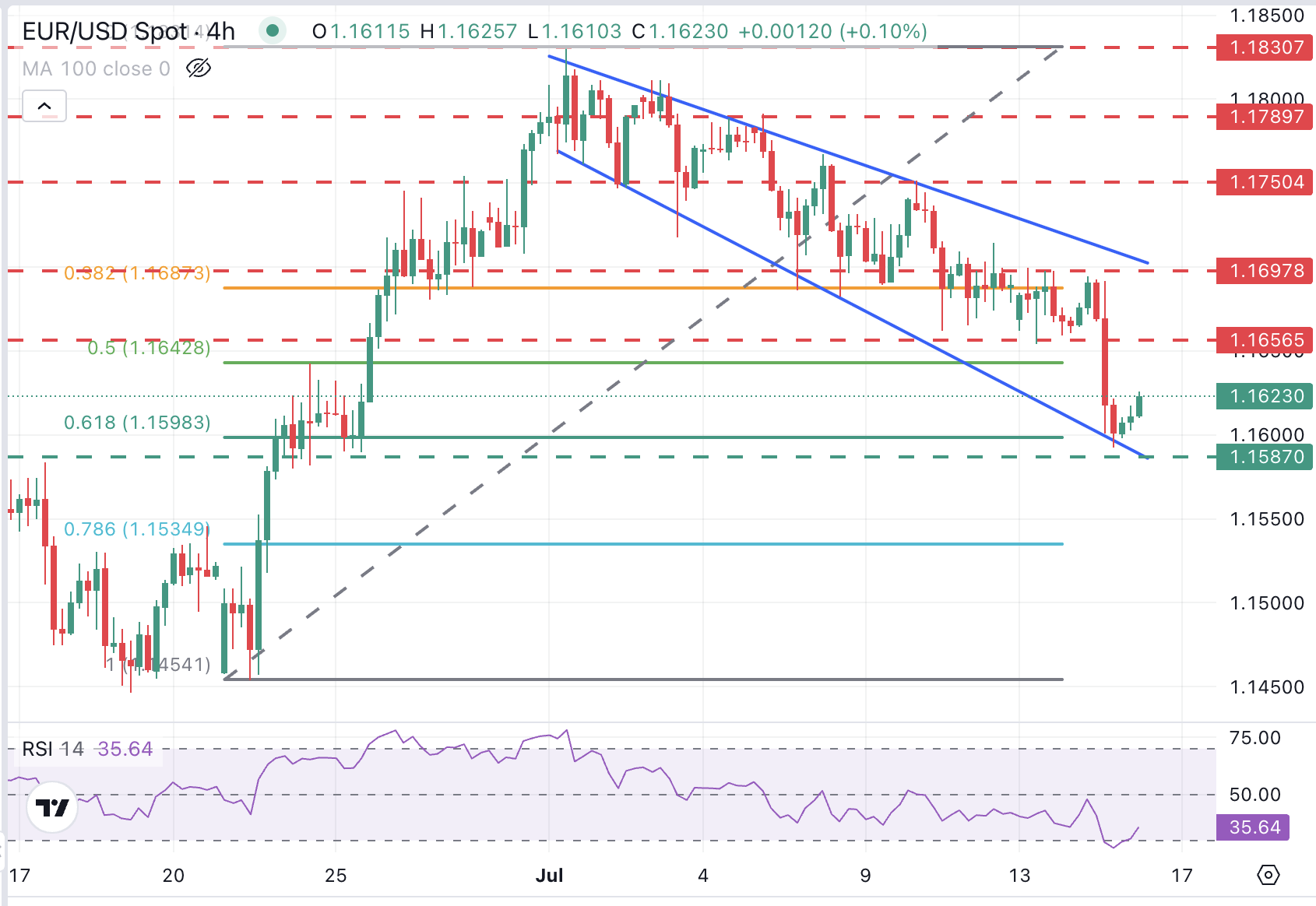- The euro runs on Wednesday against the US dollar after a 0.5% drop on Tuesday.
- The highest prices of consumers in the US confirmed the inflationary effect of tariffs and limited the hopes of rates cuts by the Fed.
- The EUR/USD continues to negotiate within a bearish trend with the resistance area of 1,1600, entering into play.
The Eur/USD He is registering small profits on Wednesday, correcting up after losing more than 0.5% on Tuesday. The US consumer price index (CPI) figures confirmed the inflationary trend provided by the Federal Reserve (Fed), limiting the hopes of feat cuts in the coming months. The US treasure yields and the US dollar (USD) shot after the publication of the data.
The Euro (EUR) bounced from a minimum of three weeks just above 1,1600 early Wednesday, reaching the 1,1620 area when opening the European session, but it is still well below the maximum of Tuesday of 1,1695. The widest trend is still bassist, since the PAR continues to register maximum and lowest minimums since it reached a peak of 1,1830 on July 1.
The US data published on Tuesday showed a notable increase in consumer inflation, with prices of various products, and particularly those of imported goods. These figures have supported the caution position of the president of the FED, Jerome Powell, who requested more time to evaluate the real impact of the tariffs of the president of the US, Donald Trump, and have led investors to cut the bets for cuts of fees in the coming months.
Meanwhile, commercial uncertainty remains high amid the lack of progress in negotiations between the EU and the US Trump promoted an agreement with Indonesia, which, however, will not avoid a 15%tariff, and announced a new round of letters to small countries, which will be notified of taxes “a little above 10%.”
The Eurozone calendar is scarce on Wednesday, and the investor approach will be in the US Production Price Index (IPP) that will be published at 12:30 GMT. The IPP will be observed with particular interest to confirm the greatest inflationary pressures shown by the consumer prices on Tuesday. If that is the case, the US dollar could continue to rise to risk aversion.
Euro price today
The lower table shows the percentage of euro change (EUR) compared to the main currencies today. Euro was the strongest currency against the US dollar.
| USD | EUR | GBP | JPY | CAD | Aud | NZD | CHF | |
|---|---|---|---|---|---|---|---|---|
| USD | -0.18% | -0.17% | -0.03% | -0.08% | -0.17% | 0.00% | -0.06% | |
| EUR | 0.18% | 0.02% | 0.16% | 0.09% | -0.04% | 0.13% | 0.13% | |
| GBP | 0.17% | -0.02% | 0.12% | 0.09% | -0.04% | 0.11% | 0.11% | |
| JPY | 0.03% | -0.16% | -0.12% | -0.05% | -0.09% | 0.00% | 0.02% | |
| CAD | 0.08% | -0.09% | -0.09% | 0.05% | -0.10% | -0.03% | 0.02% | |
| Aud | 0.17% | 0.04% | 0.04% | 0.09% | 0.10% | 0.14% | 0.15% | |
| NZD | -0.00% | -0.13% | -0.11% | -0.01% | 0.03% | -0.14% | 0.00% | |
| CHF | 0.06% | -0.13% | -0.11% | -0.02% | -0.02% | -0.15% | -0.00% |
The heat map shows the percentage changes of the main currencies. The base currency is selected from the left column, while the contribution currency is selected in the upper row. For example, if you choose the euro of the left column and move along the horizontal line to the US dollar, the percentage change shown in the box will represent the EUR (base)/USD (quotation).
What moves the market today: the euro recovers, but it is likely that the increases will be limited in the middle of the feeling of risk aversion
- The euro is rising from new minimums of several weeks on Wednesday, but the rise attempts are probably limited. Investor concerns about the greatest inflationary risks in the US and the won hopes of fed cuts probably weigh on appetite for risk, supporting demand for the US dollar as a safe refuge.
- On Tuesday, the data of the US Labor Statistics Office revealed that consumer prices grew at a rate of 0.3% in June, accelerating at a rate of 2.7% in the last 12 months, compared to 0.1% and 2.4%, respectively. The underlying IPC, which excludes the seasonal impact of food and energy, increased at an annual rate of 2.9% from 2.8% of the previous month, below the market expectations of 3%.
- The hopes of fed cuts in July fell to 3% from more than 6% before the publication of the CPI, while bets for a cut in September fell to 54% from just over 60%, according to data from the Fed Watch tool of the CME Group. The market is now valuing cuts of approximately 43 basic points (PBS) in 2025, from more than 50 PBS earlier this week.
- Despite the acceleration in prices growth, Trump continued to press the Central Bank to loosen its monetary policy. “Low consumer prices. Lower the Fed rate, now !!!” He published the president on his social truth platform. Some legislators of the Senate are exploring a new way of dismissing the president of the Fed, claiming cost overruns in the renewal of the Washington headquarters.
- The approach on Wednesday is in the June IPP data, which will be published at 12:30 GMT. Market forecasts anticipate a slight decrease in annual inflation, with general reading lowering at a rate of 2.5% year -on -year from 2.6% in May and the underlying IPP falling to 2.7% from 3% of the previous month.
- In the Eurozone, on Tuesday, the Zew economic feeling index in Germany indicated a stronger improvement than expected in the economic confidence of investors, rising to 52.7 from 47.5 in May, exceeding the expectations of a 50.0 reading. The feeling of the current economic situation also improved beyond expectations, to a reading of -59.5 from -72.0 in the previous month.
- Likewise, the industrial production of the Eurozone accelerated beyond the expectations in May, showing a monthly increase of 1.7%, exceeding the expectations of an advance of 0.9%, while the reading of April was reviewed upwards, to a contraction of 2.2% from the fall of 2.4% estimated above.
EUR/USD continues to negotiate inside a bearish channel, with the support in 1,1600 in the focus

EUR/USD It keeps intact its bearish trend since July 1. The torque is bouncing from minimums, but the rise attempts are very likely that they remain limited unless US IPP data leave well below expectations or Trump announce a significant advance in commercial conversations between the EU and the USA.
The torque is correcting upwards, with technical indicators in The 4 -hour graph, recovering from overall levels, but rising attempts will probably be challenged in the previous support area in 1.1555-1.1560 (minimum of July 13 and 14). Above here, the following objective would be the maximums of July 14 and 15, which cross the resistance of the trend line in the 1,1700 area.
Down, the torque has a significant support in the area of 1,1585-1.1600, where the 61.8% fibonacci setback of the rebound at the end of June, a common objective for corrections, meets the bottom of the channel and the minimums of June 24 and 25. Below, the fibonacci setback of 78.6% of the aforementioned cycle is at 1,1535.
Economic indicator
Consumer Price Index (Annual)
Inflation or deflationary trends are measured by periodically adding the prices of a basket of representative goods and services and presenting the data such as the consumer price index (CPI). IPC data is collected monthly and are published by the Labor Statistics Office of the USA The interannual reading compares the prices of the goods in the month of reference with the same month of the previous year. The CPI is a key indicator to measure inflation and changes in consumption trends. In general terms, a high reading is considered bullish for the US dollar (USD), while a low reading is considered bassist.
Read more.
Last publication:
Mar Jul 15, 2025 12:30
Frequency:
Monthly
Current:
2.7%
Dear:
2.7%
Previous:
2.4%
Fountain:
US Bureau of Labor Statistics
The US Federal Reserve (FED) has a double mandate to maintain price stability and maximum employment. According to this mandate, inflation should be around 2% year -on -year and has become the weakest pillar of the Central Bank directive since the world suffered a pandemic, which extends until these days. Price pressures continue to increase in the midst of problems in the supply chain and bottlenecks, with the consumer price index (IPC) at maximum levels of several decades. The Fed has already taken measures to tame inflation and it is expected to maintain an aggressive position in the predictable future
Economic indicator
Consumer price index excluding food and energy (annual)
Inflation or deflationary trends are measured by periodically adding the prices of a basket of representative goods and services and presenting the data such as the consumer price index (CPI). IPC data is collected monthly and are published by the Labor Statistics Office of the US the intermensual figure (MOM) compares the prices of the goods in the month of reference with the previous month. The IPC EX Food and Energy excludes the most volatile components of food and energy to give a more precise measurement of the pressures on prices. In general terms, a high reading is considered bullish for the US dollar (USD), while a low reading is considered bassist.
Read more.
Last publication:
Mar Jul 15, 2025 12:30
Frequency:
Monthly
Current:
2.9%
Dear:
3%
Previous:
2.8%
Fountain:
US Bureau of Labor Statistics
The United States Federal Reserve has the double mandate to maintain price stability and maximize employment. According to this mandate, inflation should be around 2% year -on -year and has become the weakest pillar of the Central Bank directive since the world suffered a pandemic, which extends to the present. The pressure on prices continues to increase due to problems and bottlenecks in the supply chain, with the Consumer Price Index (CPI) at maximum of several decades. The Fed has already taken measures to control inflation and is expected to maintain an aggressive position in the predictable future.
Source: Fx Street
I am Joshua Winder, a senior-level journalist and editor at World Stock Market. I specialize in covering news related to the stock market and economic trends. With more than 8 years of experience in this field, I have become an expert in financial reporting.







